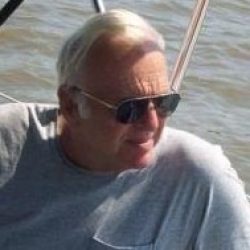
Paul Gabor Odescalchi
February 19, 1932 – September 24, 2022
Check your settings when you are happy with your print preview press the print icon below.
Show Obituaries Show Guestbook Show Photos QR Code Print
Print
Paul G. Odescalchi, 90, died in his home surrounded by his family September 24, 2022, after a brief illness. He was born February 19, 1932, in Budapest, Hungary, the son of Prince Miklos Odescalchi and Princess Virginia Tietgens Odescalchi. His early childhood was spent in the idyllic setting of his family’s estate in Tuzser, Hungary where he was initially raised. He lived there with his grandmother (Countess Palma Lonyay), his sister (Bebi), and his mother. He sailed and swam in the Tisza River, played with his sister, rode ponies, and “helped” staff with all the activities that took place at the large estate.
In 1939, Hitler invaded Poland and so, the rest of Paul’s childhood was spent in the shadow of war until the war actually entered their Budapest apartment on Christmas Eve 1944 with fearsome brutality. Sadly, Paul suffered terrible losses and witnessed atrocities, death and chaos first-hand. He lost his father, mother, sister, and home by his 13th birthday. He watched soldiers and civilians alike die violently, hid in basements, and was on the run from those who would imprison him because of his birth. He foraged for food in dead soldiers’ pockets before helping his grandmother bury them in craters left by bombs. The memories of that time never faded and stayed with him for the rest of his life.
After the war ended, Paul spent another year in Hungary under Joseph Stalin and the Communist Party’s control. He successfully escaped Communist Hungary aboard the ship Kanangoora and entered the United States on July 4, 1946, at the Port of New York. However, because it was a holiday, the longshoremen were not working, so he could not get off the ship until the next day.
Paul was met there by his beloved American sister, Pat Willson and her husband Freer. They picked him up in a rented Jeep station wagon and took him home with them – a child-refugee, thin, alien, damaged and fiercely independent by nature. Together, Pat and Freer provided him with a home, security, love and a chance for a happier future. Many years later, Paul was asked if he was afraid when he finally came to America to live, not speaking the language or knowing the culture. He said, “I was never worried, and I never doubted it. I looked at it as a chance to start over. It was a fresh start and I felt lucky to be given the chance. I never looked back.”
Paul settled into the American way of life, living in Greenwich, Connecticut with his sister and her family. He learned English by watching Westerns — associating the actors’ words with their actions on the screen. He visited his grandfather (Opa) in Florida, attended school dances and parties, celebrated holidays and went on road trips with friends. He graduated from Brunswick School in Greenwich, Connecticut in 1951.
But upon graduation, he had a problem with his immigration status – he only had a student’s visa, and he was sent a deportation letter to leave the United States. He had nowhere to go except back to Communist Hungary which was not a good option. (He could not claim citizenship based on his American mother because at that time, citizenship was based on the father’s nationality). As a result, he made the first major decision of his lifetime: to volunteer to be drafted into the United States Army.
Paul was drafted into the Army in 1951 during the Korean War and became a radio operator. He was sent to Germany for a year based on his fluency in German. He was discharged in 1953. Then, lo and behold, President Truman ordered that anyone who served in the military during a war could apply for citizenship. And so, Paul did that and he said the test was not easy at all. He passed the test, and giving up his Hungarian title of Prince, he became a red-blooded American in the summer of 1954.
Paul then made his way to the territory of Alaska (not yet a state) and obtained a job with the FAA as a surveyor. He loved Alaska, and while living there, he was deputized twice. One of his passions was flying. He bought and then…. learned to fly a 1942 Luskum 8A and later, a Cessna 140. He had a side job of flying people to different places in Alaska. (He still had the “Bill of Sale” and his “Pilot Flight Record and Logbook” in his desk when he died.) He sold his Cessna when he married his beautiful fiancée, Joyce Shankland, so they could make a down payment on their home.
Paul and Joyce married in 1962 and remained married for sixty years until his death, raising two daughters in Buckland, Virginia. During his spare time, he enjoyed gardening and growing fruit trees. He cut and split firewood to heat his home and neatly stacked the piles of wood on his property. To conserve gas, he carpooled, then purchased a motorcycle to get to work. (On his last visit to the DMV, his motorcycle license was renewed at the age of 88.) Paul became a construction worker – first as an engineer and then as a superintendent. He spent three decades building up the metropolitan area along the beltway in Virginia, Maryland and DC. He then took on smaller scale jobs until he retired at the age of 74. Among his notable projects were the World Bank, AAA Building, East Wing of the National Gallery of Art, USA Today Buildings, Key Bridge Marriot Hotel and the Federal Triangle Building.
Paul and Joyce retired in Colonial Beach, Virginia. They bought an older home with a large yard so she could pursue her passion for growing flowers, and he could sail on the Potomac River. He often rode his bicycle to the local gym, even into his late eighties – where he would work out and then ride his bicycle back home. He had a soft spot for lost and stray animals and put food out for them and sometimes brought them inside to live. Every Sunday, he made breakfast of pancakes and waffles. At 4:00 in the afternoon he had a glass of bourbon and water over ice while listening to his favorite classical music – a tradition started by his maternal grandfather, Paul Tietgens (Opa).
Paul never forgot where he came from. Although he maintained high etiquette standards set by his early childhood, he was not concerned with material possessions – choosing instead, to focus on his family, home, and hard work. He hated pretentiousness. He believed in judging a man by his character rather than preconceived ideas of social structure or privilege. As a retiree, it upset him that he was “no longer contributing to society”. He was protective of his family, instilling a traditional sense of obedience (and a little fear!) in his children that lasted long into their adulthood. He was intelligent. He was compassionate. He was brave. He was well loved and is deeply missed by his family and friends.
In addition to his parents, Paul was predeceased by sisters, Princess Margaret (Bebi) Odescalchi and Patricia Duelle Willson. Surviving in addition to his wife Joyce Shankland Odescalchi, are his daughters, Margaret Karen Ahearn and her husband, Frederick Ahearn of Colonial Beach, Victoria Odescalchi Schwaegler and her husband, Andrew Schwaegler of Orford, New Hampshire; one grandson, Paul Andrew Schwaegler of Orford, New Hampshire; his nieces Virginia Welch of Stonington, Connecticut, Victoria Quinn of Hingham, Massachusetts and Patricia Nord of Seattle, Washington; and a handful of close friends.
Visitation services will be held 6:00 p.m. – 8:00 p.m. at Storke Funeral Home in Colonial Beach on Tuesday, October 4. Interment will be at Quantico National Cemetery at 12:30 p.m. on Wednesday, October 5.
Visitation & Funeral Service Information
The family will receive friends from 6p-8p on Tuesday, October 4 at Storke Funeral Home, Colonial Beach Chapel.
A graveside service will take place at 12:30p on Wednesday, October 5 at Quantico National Cemetery.

